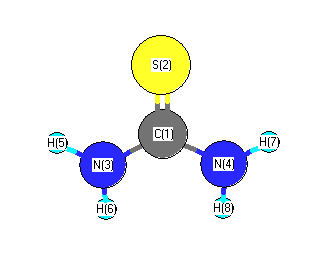Vibrational Frequencies calculated at HF/cc-pV(T+d)Z
| Mode Number |
Symmetry |
Frequency
(cm-1) |
Scaled Frequency
(cm-1) |
IR Intensities
(km mol-1) |
Raman Act
(Å4/u) |
Dep P |
Dep U |
|---|
| 1 |
A |
3950 |
3596 |
59.39 |
|
|
|
| 2 |
A |
3818 |
3476 |
31.81 |
|
|
|
| 3 |
A |
1801 |
1639 |
101.31 |
|
|
|
| 4 |
A |
1520 |
1384 |
361.23 |
|
|
|
| 5 |
A |
1143 |
1040 |
91.41 |
|
|
|
| 6 |
A |
797 |
725 |
34.40 |
|
|
|
| 7 |
A |
519 |
473 |
0.02 |
|
|
|
| 8 |
A |
494 |
449 |
3.91 |
|
|
|
| 9 |
A |
204 |
186 |
59.31 |
|
|
|
| 10 |
B |
3949 |
3595 |
72.28 |
|
|
|
| 11 |
B |
3810 |
3468 |
103.94 |
|
|
|
| 12 |
B |
1774 |
1615 |
266.10 |
|
|
|
| 13 |
B |
1546 |
1407 |
150.22 |
|
|
|
| 14 |
B |
1147 |
1044 |
19.11 |
|
|
|
| 15 |
B |
717 |
653 |
2.88 |
|
|
|
| 16 |
B |
646 |
588 |
29.85 |
|
|
|
| 17 |
B |
427 |
388 |
3.62 |
|
|
|
| 18 |
B |
321 |
292 |
421.45 |
|
|
|
Unscaled Zero Point Vibrational Energy (zpe) 14290.8 cm
-1
Scaled (by 0.9103) Zero Point Vibrational Energy (zpe) 13008.9 cm
-1
See section
III.C.1 List or set vibrational scaling factors
to change the scale factors used here.
See section
III.C.2
Calculate a vibrational scaling factor for a given set of molecules
to determine the least squares best scaling factor.
Charges, Dipole, Quadrupole and Polarizability
Charges from optimized geometry at HF/cc-pV(T+d)Z
Charges (e)
| Number |
Element |
Mulliken |
CHELPG |
AIM |
ESP |
| 1 |
C |
0.251 |
|
|
|
| 2 |
S |
-0.482 |
|
|
|
| 3 |
N |
-0.261 |
|
|
|
| 4 |
N |
-0.261 |
|
|
|
| 5 |
H |
0.210 |
|
|
|
| 6 |
H |
0.167 |
|
|
|
| 7 |
H |
0.210 |
|
|
|
| 8 |
H |
0.167 |
|
|
|
Electric dipole moments
Electric dipole components in Debye
(What's a Debye? See section
VII.A.3)
| |
x |
y |
z |
Total |
| |
0.000 |
0.000 |
-5.919 |
5.919 |
| CHELPG |
|
|
|
|
| AIM |
|
|
|
|
| ESP |
|
|
|
|
Electric Quadrupole moment
Quadrupole components in D Å
| Primitive |
|---|
| | x | y | z |
|---|
| x |
-34.874 |
1.364 |
0.000 |
| y |
1.364 |
-25.421 |
0.000 |
| z |
0.000 |
0.000 |
-28.793 |
|
| Traceless |
|---|
| | x | y | z |
|---|
| x |
-7.767 |
1.364 |
0.000 |
| y |
1.364 |
6.412 |
0.000 |
| z |
0.000 |
0.000 |
1.355 |
|
| Polar |
|---|
| 3z2-r2 | 2.709 |
|---|
| x2-y2 | -9.452 |
|---|
| xy | 1.364 |
|---|
| xz | 0.000 |
|---|
| yz | 0.000 |
|---|
|
Polarizabilities
Components of the polarizability tensor.
Units are
Å
3 (Angstrom cubed)
Change units.
| |
x |
y |
z |
| x |
4.032 |
0.069 |
0.000 |
| y |
0.069 |
6.364 |
0.000 |
| z |
0.000 |
0.000 |
8.790 |
<r2> (average value of r
2) Å
2
| <r2> |
100.417 |
| (<r2>)1/2 |
10.021 |
